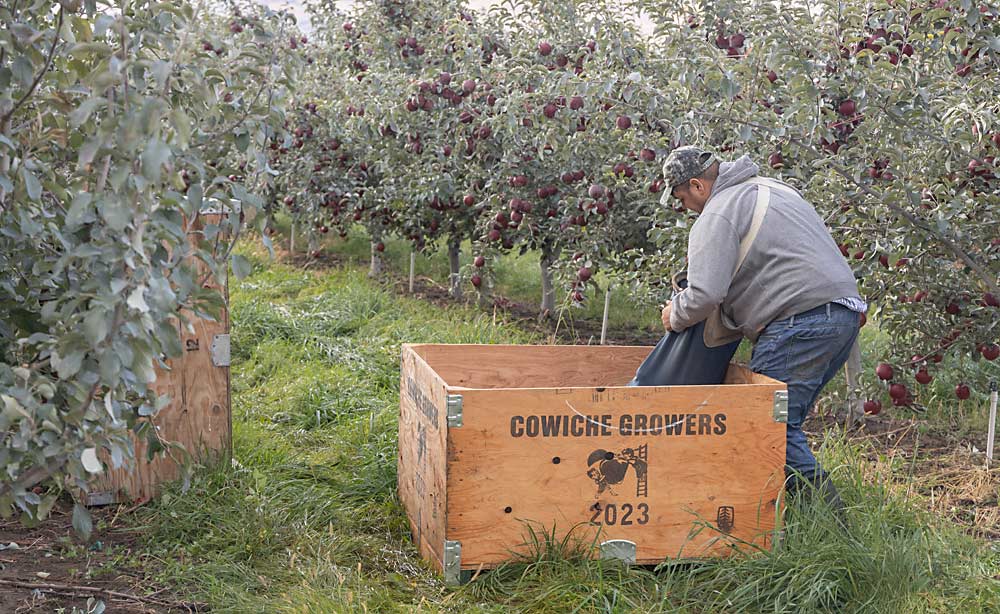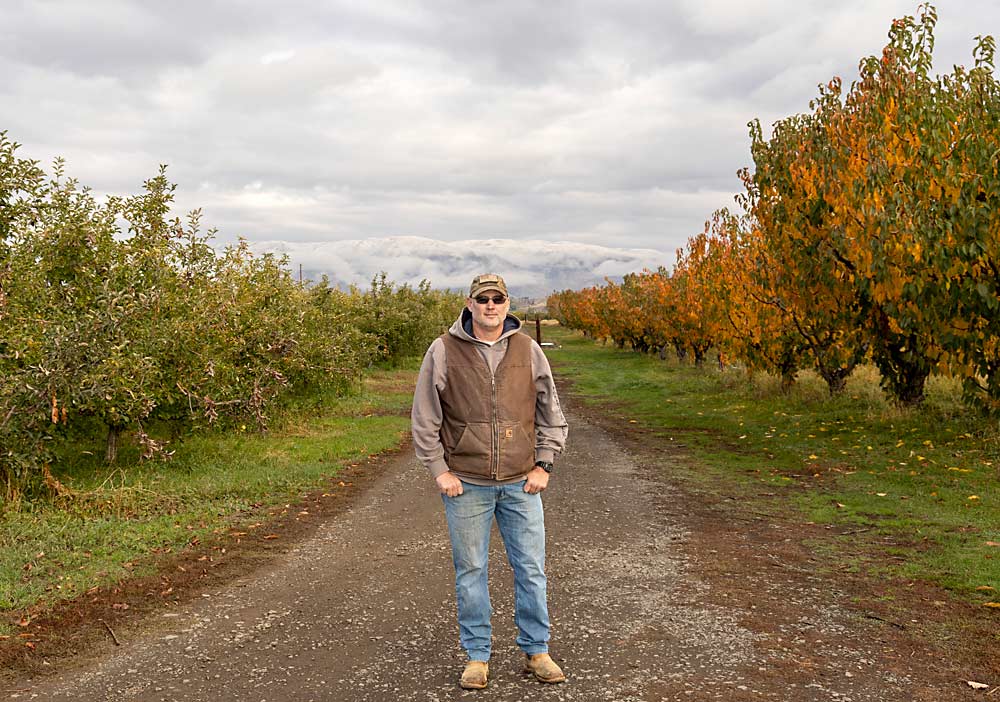
For growers in Washington’s upper Yakima Valley, most apple harvests end with a race against a forecasted hard freeze.
But with the state’s new overtime rules, that race now comes with a heavy handicap, especially for small growers, said Chuck Turner, president of the Cowiche Growers cooperative.
“It’s been a challenge to get it done,” Turner said as he neared the end of his 2023 harvest and tried to keep his workers’ hours under 48 per week, the overtime pay threshold. Temperatures were forecast to drop into the low 20s in late October, and he still had about 50 bins of WA 38 and 200 bins of Fujis to pick.
That wouldn’t work under the 40-hour limit that kicks in this year. “I would have another nine days of harvest left, and there’s no way the fruit would last that long,” Turner said. “It’s supposed to snow at the end of the week.”
AgWest Farm Credit estimates that Washington growers’ labor costs will rise 16 percent this year, between the Adverse Effect Wage Rate of $19.47 and the 40-hour overtime threshold.
Larger growers have adapted to the lowered overtime thresholds by expanding their H-2A contracts, but that comes with increasing housing, recruitment and compliance costs. But small growers, such as Turner and most of his neighbors making up the 68-member cooperative, rely on a shrinking pool of local workers.
Across the state, the combination of the large apple crop and 48-hour threshold complicated the 2023 harvest, said Jon DeVaney, president of the Washington State Tree Fruit Association.
“Moderate temperatures and generally dry conditions maximized the number of harvest days, which prevented a challenging situation from being even worse this year,” he said in December. Growers tell him that the lower threshold after Jan. 1 this year and any weather-related complications in the future could be disastrous.

Brad Newman, the general manager of Cowiche Growers, said picking fruit that can retain quality through a full storage season requires precise harvest timing.
“When you have that added cost pressure to your already high harvest labor bill, it makes it easier to fall behind,” he said. “Folks try to get by without spending overtime, and then we risk getting behind and chasing our tail on quality.”
Another co-op member, Rob McCormick of Selah, said he barely got his 2023 apple harvest done and paid overtime to do it.
“When you are getting behind on the maturity curve, you have to bite the bullet and pay it,” he said. “I don’t know how we are going to do it next (season) at 40 hours.”
He said most of the overtime went to his key employees who are managing his 250-acre operation — experienced folks he can’t just hire a few more of to keep overtime in check.
Carlos Lopez, another Cowiche-area grower, said he managed to get the harvest in without paying much overtime by cutting Saturday and Sunday shifts. Many of his workers spent those days picking at other orchards.
“A lot of them weren’t happy because this is when they are usually making their money,” he said. “Next (season) is going to be a challenge. I am already thinking about how we are going to do it.”
A few of the co-op’s growers — the largest operations — have turned to H-2A workers, Newman said, but that’s not a viable solution for most of them.
Turner ended the season with 26 employees, down from his peak of 35. Of those, “10 guys work for me all year long, and another 10 just come for harvest who are pretty loyal,” he said. The rest are sporadic hires that come and go. “A couple years ago, I filled out over 100 I-9s.”
Turner didn’t pay much attention to the 56-hour overtime rule in 2022, but in 2023, the 48-hour threshold quickly caught up with him.
“We weren’t tracking that when we started picking pears in August, and that first week cost us $7,000 extra,” he said, adding that his wife, an accountant, alerted him to the overtime cost. He quickly adjusted his schedule to limit workers’ hours. “Paying that every week would bankrupt us.”
At today’s apple prices, that’s not hyperbole.
Newman said that as he reviews prices with growers and talks to others in the industry, it’s clear the current situation of low returns and high input costs is unsustainable.
But the co-op, which just celebrated its 100th anniversary last year, has weathered tough times before, he said, citing growers’ resiliency.
The escalating labor costs drive up growers’ risk, McCormick said, because growers don’t know at harvest time if the returns they will get on their fruit can cover those extra harvest costs.
In the case of apples, “you are 80 percent in already, so you might as well pay to pick and take your chance,” he said. When it doesn’t pencil out, but the money is already spent, farms end up in financial trouble. “I think after this year, a lot of people are going to throw in the towel.”
It hurts the workers too, McCormick emphasized, when growers cut their hours down to 40 or go out of business entirely.
“What we pay to harvest apples or cherries is already overtime. Guys we normally pay $18 to $20, we are paying $30 to pick fruit. And they want as many of those hours as they can get,” he said. “I know the people making these rules are well-meaning, but they are hurting the people they think they are helping.”
—by Kate Prengaman






Leave A Comment